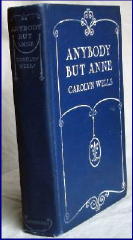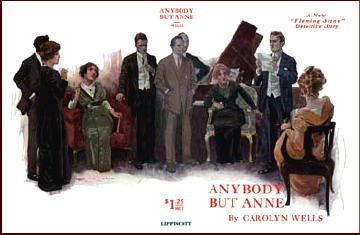Mon 2 Feb 2009
Reviewed by Mike Grost: CAROLYN WELLS – Anybody But Anne.
Posted by Steve under Authors , Characters , Reviews[2] Comments
CAROLYN WELLS – Anybody But Anne. J. B. Lippincott, US/UK, hardcover, 1914.
Anybody But Anne shares most of the characteristics of Wells’ later Faulkner’s Folly (reviewed here not too long ago):

● It is a full, formal mystery novel, of the kind that would later be popular in the Golden Age.
● It is set in a country house, and anticipates the mysteries soon to be popular in such houses.
● The cast of suspects resemble those to be found in many later detective books.
● It is a locked room mystery — but the solution of the locked room is based on ideas that would later be regarded as cheating. Still, the cheat of a solution shows some real ingenuity.
● The book shows the imagination with architecture, that would later be part of the Golden Age. It comes complete with a floor plan. The country house is of the kind that might have later inspired the mystery game known as Clue or Cluedo: there is even a billiard room!
● Wells pleasantly includes some subsidiary mysteries, that have nothing to do with the locked room. These too show some mild but pleasing ingenuity. Such subplots are also standard in Golden Age detective novels.
I do not know if Wells invented the above template for formal mystery novels, or whether she derived it from other authors. Anybody But Anne does establish, that what we think of as a “typical Golden Age style mystery novel,” was in existence before what is often thought of as the official start of the Golden Age in 1920. It is also a fact, that Wells was American, and that her book is set in the United States: somewhere in New England.
The best parts of Anybody But Anne have charm. People looking to sample Wells, might enjoy this novel, or at least its best chapters. It is at its best in the opening (Chapters 1-6), which sets up the architecture, characters and murder mystery; two later chapters that tell us more about the house as well as exploring some subsidiary mysteries (14, 17), and lastly the solution (Chapters 18, 20). Together these sections make a readable novella. The novel has been scanned by Google Books, and can be read free on-line.

We get a good portrait of Wells’ sleuth, Fleming Stone, in action in these sections. Oddly, he is missing in most of the middle of the book, sections which generally are not that interesting anyway. Like most pre-1945 detectives, he is more characterized by his skills and behavior as a detective, than by any knowledge we get of his personal life.
Stone has a penetrating intellect, that goes right to the heart of clues to the mystery, in the evidence at hand. He is crisp and business-like at delivering his insights, sharing his ideas immediately with the other characters and the reader.
We do learn that Fleming Stone is outside of the world of romance, like many other early detectives. Wells gives an interesting psychological portrait of this.
February 2nd, 2009 at 6:27 pm
Steve,
The dust jacket is fascinating. It looks like a portrait of the cast of characters – as if it were a movie ad in 2009.
The Google Books scan includes a color frontispiece, by artist Robert McCaig. It shows what look like some of the same characters. The man on the jacket spine is presumably detective Fleming Stone. He has his hands thrust in his pockets, to give him that determined, bloodhound air. He also seems to be the center man in the frontispiece, the only man in a brown suit in both pictures.
It isn’t certain, but the book’s narrator and romantic man might be the man holding the paper on the front cover. He also seems to be the man on the right in the frontispiece.
May 31st, 2020 at 7:40 am
[…] But Anne has been reviewed, among others, at Mystery File, and […]